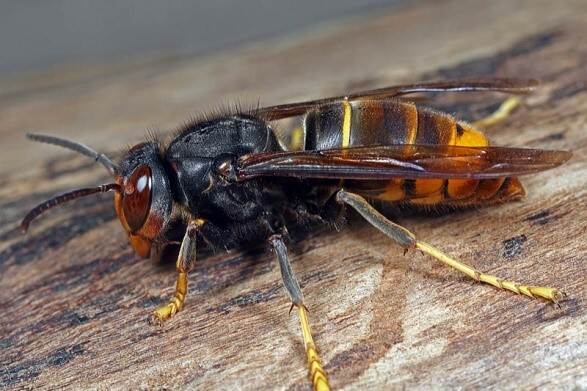In recent years, the Asian hornet, often known as the yellow-legged hornet (Vespa velutina), has raised concerns throughout Europe. These Southeast Asian native invasive species seriously threaten the local biodiversity and ecosystems.

black thorax
black antennae
yellow tip on the legs
abdomen with 2 narrow and 1 wide orange band
queen and workers about the same size
An (Asian) hornet sting may hurt more than a typical wasp sting. However, being stung by a hornet is much less likely than being stung by an ordinary wasp. Hornets avoid foods like desserts and sweets.
The impact of the Asian hornet on pollinators, especially honeybees, is one of the main issues raised by this species. It is well known that hornets feed on honeybees, essential for pollinating crops and keeping ecosystems in balance. Asian hornets seek beehives and mark them with pheromones, which causes a group of hornets to launch coordinated attacks that can completely wipe out honeybee colonies in hours. The disruption of the pollination process caused by this predatory behavior reduces crop yields in addition to having an impact on honey output.
Other insects, including beneficial species like butterflies and ladybugs, are at risk from Asian hornets’ presence. These predators and pollinators can disturb the natural food chain, which can have a negative ripple impact on plant populations and the health of the ecosystem as a whole.
In Drenthe’s Hooghalen earlier this month, a hornet queen was seen working on creating a nest. A queen was discovered in Gelderland on May 21 near Winterswijk, and one was previously spotted in Lunteren on May 4. A sighting of a queen was reported in Odijk, Utrecht, yesterday, May 29, 2023. According to reports, only Groningen and Friesland have not yet heard from anyone who has seen the hornet. This year, North Brabant has reported finding about 40 queens.

“To prevent this harmful invasive exotic from spreading even further in the Netherlands, it is important that the nests are quickly traced and destroyed,” says Reinhold for rtlnieuws.nl. “Citizens play an essential role in this because without observations, the provinces, which are responsible for the approach, cannot take action.”
Leave a Reply